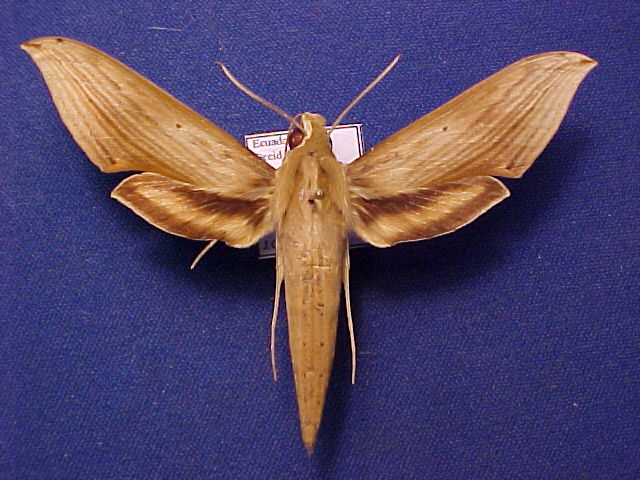Xylophanes aglaor
Xylophanes aglaor
zail-AH-fan-eesmmagh-GLAY-or or
zye-LAH-fan-eesmmagh-GLAY-or
(Boisduval, [1875]) Chaerocampa [sic]

Xylophanes aglaor courtesy of John Vriesi.
This site has been created by
Bill Oehlke at oehlkew@islandtelecom.com
Comments, suggestions and/or additional information are welcomed by Bill.
TAXONOMY:
Family: Sphingidae, Latreille, 1802
Subfamily: Macroglossinae, Harris, 1839
Tribe: Macroglossini, Harris, 1839
Genus: Xylophanes Hubner [1819] ...........
Species: aglaor Boisduval, [1875]
|
MIDI MUSIC
.....It's a Wonderful World.....
copyright C. Odenkirk
ON.OFF
<bgsound src="world.mid" LOOP=FOREVER>
|
DISTRIBUTION:
Xylophanes aglaor moths
fly in Brazil (specimen type locality) and west to
Bolivia: Santa Cruz: Ñuflo Chávez, Esperanza.
"Most similar to Xylophanes libya but generally darker and more contrastingly patterned, and with a characteristic dark brown inner edge to the tegulae and
lunate subapical spot on the forewing underside.
Inner margin of tegula dark brown (as in Xylophanes maculator and Xylophanes lichyi).
Forewing upperside as in Xylophanes libya but: ground colour darker; wing covered with scattered black scales; all five postmedian lines
(including the doubled first) generally equal in thickness, but sometimes the fourth or the fifth line slightly heavier.
Marginal band of forewing underside with basal dark patch more extensive than in
Xylophanes libya, Xylophanes loelia and Xylophanes neoptolemus, covering more than half the wing, exceeding the second, and usually the third,
postmedian line on the inner margin and often almost reaching the fourth; area between first and fourth postmedian lines yellow, contrasting with the more orange
coloration on either side (similar to the condition in Xylophanes neoptolemus but less distinct); black subapical spot on the costa distinctly lunate.
Median band of hindwing upperside narrower than in Xylophanes libya, with a consequently broader marginal band." CATE
FLIGHT TIMES:
Xylophanes aglaor adults fly????
ECLOSION:
Pupae probably wiggle to surface from subterranean chambers just prior to eclosion.
SCENTING AND MATING:Females call in the males with a pheromone released from a gland at the tip of the
abdomen. Males come in to lights very readily, but females are seldom taken in that way.
EGGS, LARVAE, PUPAE:
Larvae probably feed on Psychotria panamensis and Psychotria nervosa
of the Rubiaceae family and on
Pavonia guanacastensisof the Malvaceae family.
Moths emerge approximately one-two months after larvae pupate.
The pronunciation of scientific names is
troublesome for many. The "suggestion" at the top of the page is
merely a suggestion. It is based on commonly
accepted English pronunciation of Greek names and/or some
fairly well accepted "rules" for latinized scientific names.
The suggested pronunciations, on this page and on other pages,
are primarily put forward to assist those who hear with internal
ears as they read.
There are many collectors from different countries whose
intonations and accents would be different.
Jean Marie Cadiou writes, "When I say "Xylophanes" in English I
pronounce it something like "Zailophanees", with the emphasis on the
"o". The French pronounce it differently, something like
"Kzeelophaness" with no emphasis, and the Germans yet in a
different way..."
In Greek myth, Phanes is the golden winged Primordial Being who
was hatched from the shining Cosmic Egg that was the source of the
universe. He personifies light emerging from chaos.
"Xylo" is the Greek word for wood.
The specimen type for the genus
Xylophanes is Xylophanes anubus. Perhaps ? when Hubner
examined that species, the yellow-orange and brown tones of the
forewings suggested wings of wood.
The species name "aglaor" might refer to
a fairie tale Prince Aglaor who slays an ogre for the Princess's hand.
Use your browser "Back" button to return to the previous page.
Goto Main Sphingidae Index
Goto Macroglossini Tribe
Goto Central American Indices
Goto Carribean Islands
Goto South American Indices
Goto U.S.A. tables
